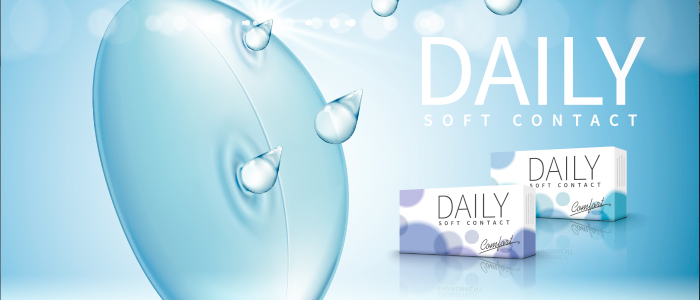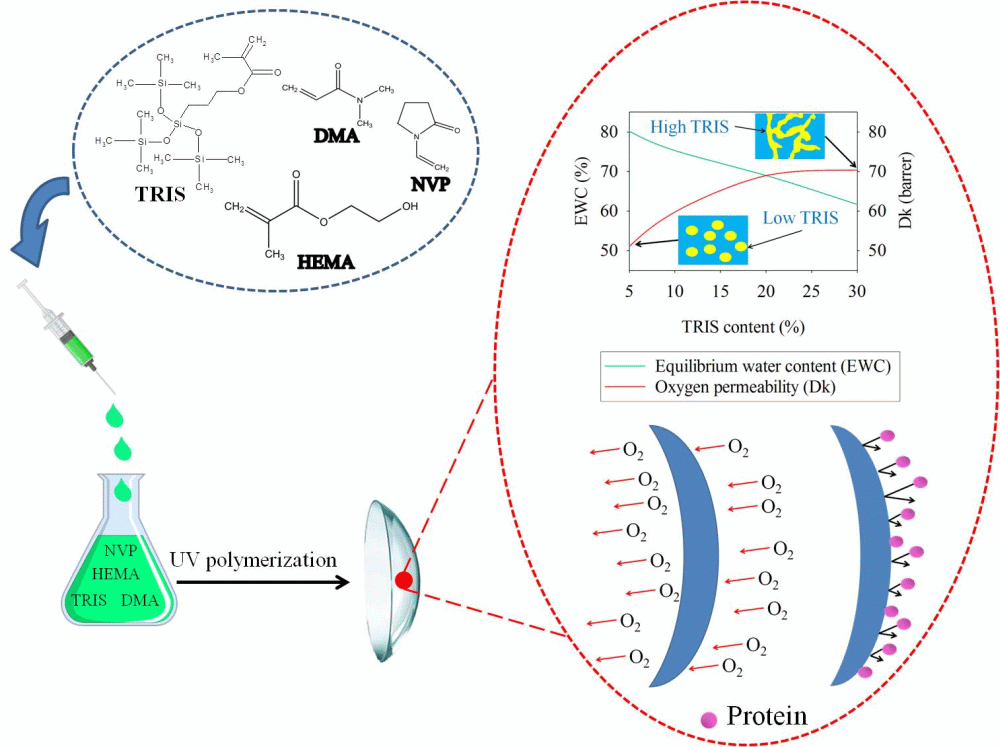Hema Polymer Contact Lenses
It has a typical oxygen permeability of 05 DK which makes it effectively an impermeable membrane to oxygen and carbon dioxide. Original hydrogel contact lenses made of polyHEMA 2-hydroxy-ethyl methacrylate crosslinked with ethylene glycol dimethacrylate EDMA.
 Are Daily Contact Lenses My Best Choice
Are Daily Contact Lenses My Best Choice
Currently wearing daily disposable lenses.

Hema polymer contact lenses. The early soft lenses were about 38 water but modern hydrogel lenses may be up to 70 water. Hydroxyethyl methacrylate HEMA is used to make the hydrophilic polymer. The commonest and in some ways the simplest of these is the first hydrogel material used for contact lens wear poly 2-hydroxyethyl methacrylate or polyHEMA sometimes simply referred to as HEMA the constituent monomer which was developed by Wichterle in the 1960s 12.
Cylinder less than or equal to 075 D. PMMA is an ideal polymer to be used for hard contact lenses because it is cheap and easy to make. These lenses provided clear vision and comfort but there was a problem.
Willing and able to wear spherical contact lenses for protocol-specified timeframe within the available range of powers -100 D to -600D in 025D steps. This is a polymer made of 2-hydroxyethylmethacrylate HEMA cross-linked to ethylene glycol dimethacrylate. But in addition using other monomers such as NVP n vinyl pyrollidone to improve properties such as water content strength or resistance to deposits.
We investigated the corresponding capillary flow behaviors in these microchannels. Attempts to improve the properties have resulted in using polyHEMA. The 2-HEMA polymer is used in certain contact lenses where it has the additional advantage of being rigid and easy to shape with grinding tools when it is dry and then becomes flexible when it absorbs water.
The cooperation of 2-methacryloyloxyethyl phosphorylcholine and vinyl ether terminated polydimethylsiloxane macro-monomer improved the oxygen permeability of hydrogel contact lenses 4. Hard contact lenses were made of polymethymethacrylate PMMA while the soft contact lenses were made of a hydrated polymer hydroxyethylmethacrylate HEMA which contained 378 water by weight. Poly is a polymer that forms a hydrogel in water.
Partition coefficient is found to be strong function of degree of crosslinking. Up until the late 1970s contact lenses were made from two materials. It was synthesized by Wichterle and Lim with the purpose of developing soft contact lenses with greater oxygen permeability and more comfortable than hard poly methyl methacrylate PMMA lenses used until then.
Here we report the fabrication of microchannels in poly 2-hydroxyethyl methacrylate poly HEMA hydrogels that are used in commercial contact lenses with a three-dimensional 3D printed mold. Theoretical models do not yield accurate values of lysozyme diffusivity. Visual acuity with study lenses 2025 or better.
Because of this property it was one of the first materials to be successfully used in the manufacture of soft contact lenses. Together they succeeded in preparing a cross-linking gel which absorbed up to 40 of water exhibited suitable mechanic. The glass transition temperature of polyHEMA is above 100 C.
HEMA can be shaped into a contact lens PolyHEMA a soft flexible water-absorbing plastic used to make soft contact lenses. In conventional contact lenses increasing the water content increases the Dkt and amount of oxygen that transmits to the cornea through the lens. Depending on the physical and chemical structure of the polymer it is capable of absorbing from 10 to 600 water relative to the dry weight.
Other protocol-defined inclusion criteria may apply. It is moderately hydrophobic which also contributes to it repelling proteins effectively. It is anticipated that the irritation caused by the contact lens can be totally eliminated by using hydroxyethyl methacrylate HEMA to replace PDMS for the contact lenses.
Lysozyme transport in p-HEMA hydrogel contact lenses is diffusion controlled. This impermeability is what restricts PMMA lenses from being used more then about 8 hours at a time. A simple soaking of gel overnight may not completely remove protein absorbed.
In addition the polymerization of 2-hydroxyethyl methacrylate HEMA with PDMS provided more oxygen permeability than non-silicone hydrogel 5. It was invented by Drahoslav Lim and Otto Wichterle for biological use. 27 Consequently crosslinked HEMA polymerized in bulk xerogel is a hard material that can be cut into blocks and worked up on a lathing machine similarly to the production of hard contact lenses from poly methyl methacrylate.
Lysozyme binds to polymer chains with a concentration dependent partition coefficient. These lenses rely on the amount of water in the polymer to regulate how much oxygen can pass through the lens. Since water is used to allow oxygen permeation these lenses increase gas exchange by getting larger.
Poly hydrogel for intraocular lens materials was synthesized by solution polymerization using 2-hydroxyethyl methacrylate as raw material ammonium persulfate and sodium pyrosulfite as catalyst and triethyleneglycol dimethacrylate as cross-linking additive. The use of silicone polymers containing an inorganic backbone of silicon and oxygen with organic side groups in contact lenses is nothing new. It is a polymer of 2-hydroxyethyl methacrylate HEMA a clear liquid compound obtained by reacting methacrylic acid CH2CCH3CO2H with ethylene oxide or propylene oxide.
 Bellalens Colored Contacts Contact Lenses Colored Colored Contacts Colored Eye Contacts
Bellalens Colored Contacts Contact Lenses Colored Colored Contacts Colored Eye Contacts
 Lentilles De Contact De Couleur Bleu Ocean Blue De Luxdelux Dual Tone Design Hydrophi Lentilles De Contact Couleur Yeux Bleu Clair Yeux Magnifiques
Lentilles De Contact De Couleur Bleu Ocean Blue De Luxdelux Dual Tone Design Hydrophi Lentilles De Contact Couleur Yeux Bleu Clair Yeux Magnifiques
 Freshlook Colorblends Sterling Gray 2 Lenses Contact Lenses Colored Colored Contacts Green Contacts Lenses
Freshlook Colorblends Sterling Gray 2 Lenses Contact Lenses Colored Colored Contacts Green Contacts Lenses
 Flash Sale Diamonds Glitter Grey 12 Month Contact Lenses Cosmetic Contact Lenses Contact Lenses Colored Contact Lenses
Flash Sale Diamonds Glitter Grey 12 Month Contact Lenses Cosmetic Contact Lenses Contact Lenses Colored Contact Lenses
 Contact Lenses The Organic Solution
Contact Lenses The Organic Solution
 Advances In Chemistry And Composition Of Soft Materials For Drug Releasing Contact Lenses Rsc Advances Rsc Publishing Doi 10 1039 D0ra06681h
Advances In Chemistry And Composition Of Soft Materials For Drug Releasing Contact Lenses Rsc Advances Rsc Publishing Doi 10 1039 D0ra06681h
 Shakespeare S Dream Colored Contacts Coloured Contact Lenses Change Your Eye Color
Shakespeare S Dream Colored Contacts Coloured Contact Lenses Change Your Eye Color
 Contact Lens Spectrum Where Are All The Smart Lenses
Contact Lens Spectrum Where Are All The Smart Lenses
 Polymers Free Full Text Synthesis And Characterization Of Silicone Contact Lenses Based On Tris Dma Nvp Hema Hydrogels Html
Polymers Free Full Text Synthesis And Characterization Of Silicone Contact Lenses Based On Tris Dma Nvp Hema Hydrogels Html
 Advances In Chemistry And Composition Of Soft Materials For Drug Releasing Contact Lenses Rsc Advances Rsc Publishing Doi 10 1039 D0ra06681h
Advances In Chemistry And Composition Of Soft Materials For Drug Releasing Contact Lenses Rsc Advances Rsc Publishing Doi 10 1039 D0ra06681h
 Eyecandys Pink Label Aida Brown Colored Eye Contacts Contact Lenses Colored Best Colored Contacts
Eyecandys Pink Label Aida Brown Colored Eye Contacts Contact Lenses Colored Best Colored Contacts
 Vcee Wildcat Green Colored Contact Lenses Contact Lenses Colored Green Colored Contacts Colored Contacts
Vcee Wildcat Green Colored Contact Lenses Contact Lenses Colored Green Colored Contacts Colored Contacts
 Luna Eos Ice Ii 2 Tone Soft Cosmetic Contact Lenses 7 Colors Available Blue Brown Violet Gree Cosmetic Contact Lenses Contact Lenses Colored Colored Contacts
Luna Eos Ice Ii 2 Tone Soft Cosmetic Contact Lenses 7 Colors Available Blue Brown Violet Gree Cosmetic Contact Lenses Contact Lenses Colored Colored Contacts
 Contact Lenses Surface Chemistry Eag Laboratories
Contact Lenses Surface Chemistry Eag Laboratories
 Buy Royal Vision Creamy Greenish Blue Colored Contacts Eyecandys
Buy Royal Vision Creamy Greenish Blue Colored Contacts Eyecandys
 Lorry 3 Colors Contact Lenses Unicoeye Contact Lenses Colored Colored Contacts Contact Lenses
Lorry 3 Colors Contact Lenses Unicoeye Contact Lenses Colored Colored Contacts Contact Lenses
 Freshgo Hidrocor Colored Contact Lenses Mel
Freshgo Hidrocor Colored Contact Lenses Mel
 Sl29 Brown Contact Lenses Abeecons Green Contacts Lenses Brown Contact Lenses Contact Lenses
Sl29 Brown Contact Lenses Abeecons Green Contacts Lenses Brown Contact Lenses Contact Lenses
 Advances In Chemistry And Composition Of Soft Materials For Drug Releasing Contact Lenses Rsc Advances Rsc Publishing Doi 10 1039 D0ra06681h
Advances In Chemistry And Composition Of Soft Materials For Drug Releasing Contact Lenses Rsc Advances Rsc Publishing Doi 10 1039 D0ra06681h